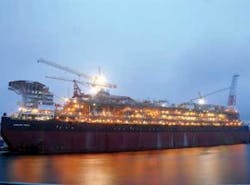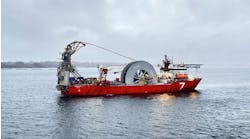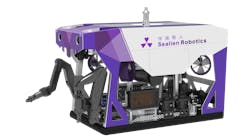John Waggoner - Technology Editor, Drilling & Production
Chevron’s Agbami is one of the largest deepwater discoveries ever in Nigeria.
The project was selected for the Top 5 for its scale and commitment to develop the West African country’s petroleum reserves and local engineering capabilities.
The Agbami field, discovered in 1998, is estimated to hold potentially recoverable volumes of 900 MMbbl of oil. First oil from Agbami was July 29, 2008, in a major accomplishment for the operator in Nigeria.
“Agbami’s initial gross oil equivalent production has ramped up to more than 110,000 b/d. We anticipate the ramp-up to continue, reaching 250,000 b/d by the end of 2009,” says George Kirkland, EVP Upstream and Gas, Chevron.
The discovery is in OPL block 216 with water depths ranging from 4,200 ft to 5,400 ft (1,280 m to 1,646 m), making this the deepest project ever in Nigeria. The field is 70 mi (113 km) offshore the central Niger Delta, about 220 mi (354 km) southeast of Lagos, and spans 45,000 acres (182 sq km).
Development drilling and completion operations began in 2006. Subsea installation of production equipment began in 2007.
Sweet and light
As with many other West African discoveries, it is primarily an oil field with associated gas. Oil from the reservoir is light (47° API), sweet crude with low levels of contaminants. Associated gas is reinjected to the reservoir for pressure maintenance and to eliminate gas flaring.
Chevron operates the project with a 68.2% interest. Partners include the Nigerian National Petroleum Co., Famfa Oil, Petrobras, and Statoil.
The Agbami project FPSO.
The $5.4-billion project was based on a newbuild FPSO system and subsea wells.
The FPSO was delivered to Nigeria from South Korea in December 2007. It is a spread-moored monohull vessel with a storage capacity of 2.1 MMbbl, with a process facility designed for 250,000 b/d, 450,000 MMcf/d of gas and 450,000 b/d of water. The export system consists of a single point mooring system with two steel offloading lines extending from the FPSO to the SPM. The Agbami subsea production risers bring production from the subsea manifolds and wells to the FPSO and deliver injection gas and water to subsea wells.
Chevron and Nigeria
Chevron Nigeria Ltd. (CNL), Chevron’s principal subsidiary in Nigeria, operates and holds a 40% interest in 13 concessions covering 2.2 million acres (8,900 sq km), predominantly in the onshore and near-offshore regions of the Niger Delta.
CNL operates under a joint-venture arrangement with the Nigerian National Petroleum Corp., which owns 60%.
In 2007, total daily production from 32 fields averaged 353,000 bbl of crude oil, 14 MMcf of natural gas and 4,000 bbl of liquefied petroleum gas (LPG). The company’s net oil-equivalent production in 2007 was 129,000 b/d.
Chevron has a large acreage position in deepwater offshore Nigeria, with interests in 12 deepwater blocks. In addition to Agbami, the company operates block 1 in the Nigeria–São Tomé e Príncipe Joint Development Zone (JDZ) with a 45.9% funding interest.
The local factor
The Agbami project represents a commitment to develop the local workforce and construction capabilities in Nigeria.
Overall, about 11,800 tons (10,705 metric tons) of major offshore components for Agbami were fabricated by local firms, making this the largest ever use of local content in any Nigerian deepwater project.
Workers checking controls on the Agbami FPSO, offshore Nigeria. Gauges, controls, and equipment are visible.
Nigerian entities performed more than 3.3 million man-hours of detailed engineering, construction, and training for the design and fabrication of offshore facilities. Nigerdock, DNL, and Grinaker-LTA upgraded and expanded their Nigerian yards, and more than 1,000 jobs were created.
Nigerians involved in the project had the opportunity to improve technical skills in various areas — detailed engineering, fabrication, and construction, project management and supervision — which took place in several parts of the world including Europe, Korea, USA, and Nigeria.
An Operations & Management training facility was opened for 76 students initially, and later expanded to include about 300 students for other projects over a three-year period. A commercial model has been developed for this to be a self sustaining training facility open to the industry.
Creation of value
Value creation in Nigeria for the major contractors and local subcontractors and vendors in the supply chain and technical services was estimated to be worth $1.8 billion.
Two FPSO topsides modules and the Agbami offloading buoy and suction piles for the buoy and FPSO were produced locally by Nigerdock in Lagos. Grinaker-LTA in Port Harcourt fabricated the manifolds and associated suction piles. All components were loaded out of both yards and shipped to South Korea to be integrated with the FPSO topsides.
Two additional modules and flare bloom were constructed at the Daewoo yard in Warri, Nigeria. The 7P module weighs 1,700 tons (1,543 metric tons) and is the largest and heaviest ever fabricated in the country.
FMC Technologies of Houston built a new service base at the Onne Oil & Gas Free Zone in Port Harcourt, Rivers state, to promote capacity use and to boost the supply chain in Nigeria. The base serves for warehousing, testing, and servicing of subsea trees and equipment. The facility also serves the needs of other FMC clients in Nigeria.
More than 100 Nigerian engineers were trained as part of a program in South Korea, the US, and Nigeria, in fields such as naval architecture, marine engineering, piping, instrumentation, flow assurance, and process engineering.






